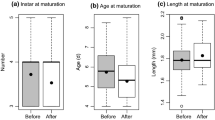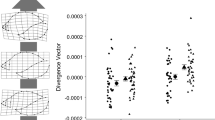Abstract
Predators can impose both selection and life-history shifts in prey populations. Because both processes may affect phenotypic distributions, the estimates of selection differentials may be biased. We carried out two field experiments to disentangle these separate effects. We studied whether dragonfly predation by Aeshna cyanea changes the distributions in body size and lamellae morphology in the damselfly Lestes sponsa. Damselflies have caudal lamellae which are used in escapes by swimming. In a first experiment, we manipulated predator presence (No Aeshna, Encaged Aeshna or Free-ranging Aeshna) and stopped the experiment when all larvae had moulted once. In a second experiment, larvae were confronted with a Free-ranging Aeshna but collected before moulting, and survivors were compared with a control sample taken at the start of the experiment. The presence of Aeshna largely reduced the survival probabilities of the Lestes larvae at a very similar rate in both experiments. Daily survival probabilities did not differ between the No Aeshna and Encaged Aeshna treatments. In the Free-ranging Aeshna treatment of the first experiment, size was reduced compared to the other two treatments, creating a significant apparent selection differential. This was probably mainly due to predator-induced reduced growth because in the second experiment, where growth effects were excluded, size of the survivors did not differ from the control sample. In both experiments there was a significant selection pressure for larger lamellae. Standardized directional selection differentials were similar in both experiments (0.57 and 0.28 phenotypic standard deviation units). No survival selection on lamellae shape was detected. These results are in agreement with previous findings that lamellae size, but not lamellae shape, enhances swimming performance and thereby predator escape in this species.
Similar content being viewed by others
References
Ball, S.L. and Baker, R.L. (1996) Predator-induced life history changes: antipredator behavior costs or facultative life history shifts? Ecology 77, 1116–1124.
Breden, F. and Wade, M.J. (1989) Selection within and between kin groups of the imported willow leaf beetle. Am. Nat. 134, 35–50.
Burnside, C.A. and Robinson, J.V. (1995) The functional morphology of caudal lamellae in coenagrionid (Odonata, Zygoptera) damselfly larvae. Zool. J. Linn. Soc. 114, 155–171.
Chivers, D.P., Wisenden, B.D. and Smith, R.J.F. (1996) Damselfly larvae learn to recognize predators from chemical cues in the predator's diet. Anim. Behav. 52, 315–320.
Corbet, P.S., Longfield, C. and Moore, N.W. (1985) Dragonflies. Collins, London.
Crowl, T.A. and Covich, A.P. (1990) Predator-induced life-history shifts in a freshwater snail. Science 247, 949–951.
Dixon, S.M. and Baker, R.L. (1988) Effects of size on predation risk, behavioural response to fish, and cost of reduced feeding in larval Ischnura verticalis (Coenagrionidae: Odonata). Oecologia 76, 200–205.
Endler, J.A. (1986) Natural Selection in the Wild. Princeton University Press, Princeton, NJ.
Eriksen, C.H. (1986) Respiratory roles of caudal lamellae (gills) in a lestid damselfly (Odonata: Zygoptera). J. N. Amer. Benth. Soc. 5, 16–27.
Gosler, A.G., Greenwood, J.J.D. and Perrins, C. (1995) Predation risk and the cost of being fat. Nature 377, 621–623.
Gunnarsson, B. (1998) Bird predation as a sex-and size-selective agent of the arboreal spider Pityohyphantes phrygianus. Funct. Ecol. 12, 453–458.
Jeffries, M. (1990) Interspecific differences in movement and hunting success in damselfly larvae (Zygoptera: Insecta): responses to prey availability and predation threat. Freshw. Biol. 23, 191–196.
Johansson, F. (1993) Intraguild predation and cannibalism in odonate larvae: effects of foraging behaviour and zooplankton availability. Oikos 66, 80–87.
Johnson, D.M. (1991) Behavioral ecology of larval dragonflies and damselflies. Trends Ecol. Evol. 6, 8–13.
Jödicke, R. (1997) Die Binsenjungfern und Winterlibellen Europas. Westarp, Magdeburg.
Kingsolver, J.G. and Schemske, D.W. (1991) Path analysis of selection. Trends Ecol. Evol. 6, 276–280.
Lande, R. and Arnold, S.J. (1983) The measurement of selection on correlated characters. Evolution 37, 1210–1226.
Laurila, A., Kujasalo, J. and Ranta, E. (1998) Predator-induced changes in life-history in two anuran tadpoles: effects of predator diet. Oikos 83, 307–317.
Lima, S.L. (1998) Stress and decision making under the risk of predation: recent developments from behavioral, reproductive, and ecological perspectives. Adv. Study Behav. 27, 215–290.
Littell, R.C., Milliken, G.A., Stroup, W.W. and Wolfinger, R.D. (1996) SAS system for mixed models. SAS Institute, Cary.
Macan, T.T. (1977) The influence of predation on the composition of fresh-water animal communities. Biol. Rev. 52, 45–70.
Mauricio, R. and Rausher, M.D. (1997) Experimental manipulation of putative selective agents provides evidence for the role of natural enemies in the evolution of plant defense. Evolution 51, 1435–1444.
McCollum, S.A. and Van Buskirk, J. (1996) Costs and benefits of a predator-induced polyphenism in the Gray Treefrog Hyla chrysoscelis. Evolution 50, 583–593.
McCollum, S.A. and Leimberger, J.D. (1997) Predator-induced morphological changes in an amphibian: predation by dragonflies affects tadpole shape and color. Oecologia 109, 615–621.
McNeill, N. (1960) A study of the caudal gills of dragonfly larvae of the sub-order Zygoptera. Proc. Royal Irish Acad. 61(B), 115–140.
McPeek, M.A. (1990) Determination of species composition in the Enallagma damselfly assemblages of permanent lakes. Ecology 71, 83–98.
McPeek, M.A. (1995) Morphological evolution mediated by behavior in the damselflies of two communities. Evolution 49, 749–769.
McPeek, M.A. (1997) Measuring phenotypic selection on an adaptation: lamellae of damselflies experiencing dragonfly predation. Evolution 51, 459–466.
McPeek, M.A. (1998) The consequences of changing the top predator in a food web: a comparative experimental approach. Ecol. Monogr. 68, 1–23.
McPeek, M.A. and Brown, J.M. (1999) Building a regional species pool: diversification of the Enallagma damselflies in eastern north American waters. Ecology, in press.
McPeek, M.A., Schrot, A.K. and Brown, J.M. (1996) Adaptation to predators in a new community: swimming performance and predator avoidance in damselflies. Ecology 77, 617–629.
O'Carroll, D. (1993) Feature-detecting neurons in dragonflies. Nature 362, 541–543.
Pritchard, G. (1965) Prey capture by dragonfly larvae (Odonata: Anisoptera). Can. J. Zool. 43, 271–289.
Pritchard, G. (1986) The operation of the labium in larval dragonflies. Odonatologica 15, 451–456.
Schneider, D.W. (1997) Predation and food web structure along a habitat duration gradient. Oecologia 110, 567–575.
Sokal, R.R. and Rohlf, F.J. (1995) Biometry. W.H. Freeman and company, New York.
Stoks, R. (1998) Effect of lamellae autotomy on survival and foraging success of the damselfly Lestes sponsa (Odonata: Lestidae). Oecologia 117, 443–448.
Stoks, R. (1999a) Natural and sexual selection in the damselfly Lestes sponsa. Unpublished Ph.D. thesis, University of Antwerp.
Stoks, R. (1999b) The effect of autotomy and sexual size dimorphism on startle-response performance in larvae of a lestid damselfly (Odonata). J. Zool. 247, 269–273.
Stoks, R. and De Block, M. (1999) The influence of prey age and predator species on the efficacy of an antipredator behaviour: lamellae autotomy in a damselfly. Arch. Hydrobiol, in press.
Swain, D.P. (1992a) The functional basis of natural selection for vertebral traits of larvae in the stickleback Gasterosteus aculeatus. Evolution 46, 987–997.
Swain, D.P. (1992b) Selective predation for vertebral phenotype in Gasterosteus aculeatus: reversal in the direction of selection at different larval sizes. Evolution 46, 998–1013.
Trussell, G.C. (1996) Phenotypic plasticity in an intertidal snail: the role of a common crab predator. Evolution 50, 448–454.
Van Buskirk, J., McCollum, S.A. and Werner, E.E. (1997) Natural selection for environmental induced phenotypes in tadpoles. Evolution 51, 1983–1992.
Van Buskirk, J. and Yurewicz, K.L. (1998) Effects of predators on prey growth rate: relative contributions of thinning and reduced activity. Oikos 82, 20–28.
Wade, M.J. and Kalisz, S. (1990) The causes of natural selection. Evolution 44, 1947–1955.
Wiggins, D.A. (1991) Natural selection on body size and laying date in the three swallow. Evolution 45, 1169–1174.
Wiseman, S.W., Cooper, S.D. and Dudley, T.L. (1993) The effects of trout on epibenthic odonate naiads in stream pools. Freshw. Biol. 30, 133–145.
Wissinger, S. and McGrady, J. (1993) Intraguild predation and competition between larval dragonflies: direct and indirect effects on shared prey. Ecology 74, 207–218.
Author information
Authors and Affiliations
Rights and permissions
About this article
Cite this article
Stoks, R., De Block, M., Van Gossum, H. et al. Phenotypic shifts caused by predation: selection or life-history shifts?. Evolutionary Ecology 13, 115–129 (1999). https://doi.org/10.1023/A:1006656616539
Issue Date:
DOI: https://doi.org/10.1023/A:1006656616539




